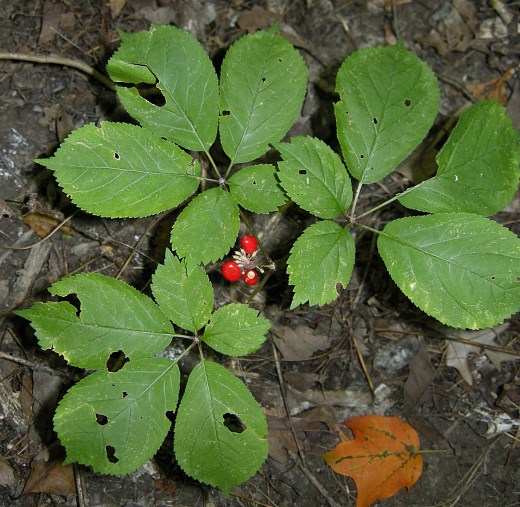Description: This perennial wildflower is about 1-2' tall and similarly across. It has a single erect stem that is hairless and unbranched; the stem terminates in a whorl of about 3 compound leaves. Each compound leaf is palmate with 5 widely spreading leaflets; the petiole (basal stalk) of each compound leaf is 2-5" long. Individual leaflets are 2½–6" long and ¾–2½" across; they are ovate to obovate, medium green, hairless, and finely serrated along their margins. The lower pair of leaflets are smaller in size than the other leaflets. The larger leaflets have longer petiolules (basal stalklets) than the smaller leaflets, and they have short slender tips.

From the terminal
point of the central stem, there develops a single umbel of greenish
white flowers. There are about 10-20 flowers per umbel; each umbel is
about ½–¾" across. Individual flowers are only 1/8" (3 mm.) across;
each flower
has 5 spreading petals, a short tubular calyx, 5 stamens, and a pistil.
The calyx has 5 tiny teeth. The blooming period occurs from early to
mid-summer and lasts about 2 weeks. During the fall, fertile flowers
are replaced by a small cluster of bright red berries spanning about ¾"
across. Each berry is globoid-ovoid in shape and contains about 2
seeds. The root system consists of a fleshy taproot that is fusiform in
shape (widest in the middle and tapering at both ends); this taproot
can be several inches long. American Ginseng reproduces by reseeding
itself.
Cultivation:
The preference is medium to light shade, a rich loamy soil with
abundant organic material, and mesic conditions.
Range & Habitat:
The native American Ginseng is distributed throughout Illinois, but it
is
relatively uncommon. Populations have declined because of habitat
destruction and overcollection of the fleshy roots. This wildflower is
found mesic deciduous woodlands. Usually, such woodlands are high
quality and little-disturbed.
Faunal Associations:
Very little is known about floral-faunal relationships for this
species. Probably small bees and various flies visit the flowers for
nectar or pollen. The red berries are probably eaten to a limited
extent by woodland birds that either nest or search for food on the
ground; small rodents may eat the berries as well.
Photographic Location:
Spitzler Woods Nature Preserve in Macon County, Illinois. This preserve
contains a high quality
deciduous woodland. The photograph was taken during the autumn, when
the berries become mature.
Comments:
It is unfortunate that this classic woodland wildflower has become
uncommon. American Ginseng is a member of a small group of plants in
the Araliaceae; these consist primarily of woodland
wildflowers in Illinois. Another woodland wildflower that does not
occur within the state, Panax trifolius (Dwarf
Ginseng), is found further to the east. Dwarf Ginseng is smaller in
size (about 6" tall) than American Ginseng, and its compound leaves are
trifoliate, rather than palmate with 5 leaflets. The flowers and
berries of these two species are similar to each other.